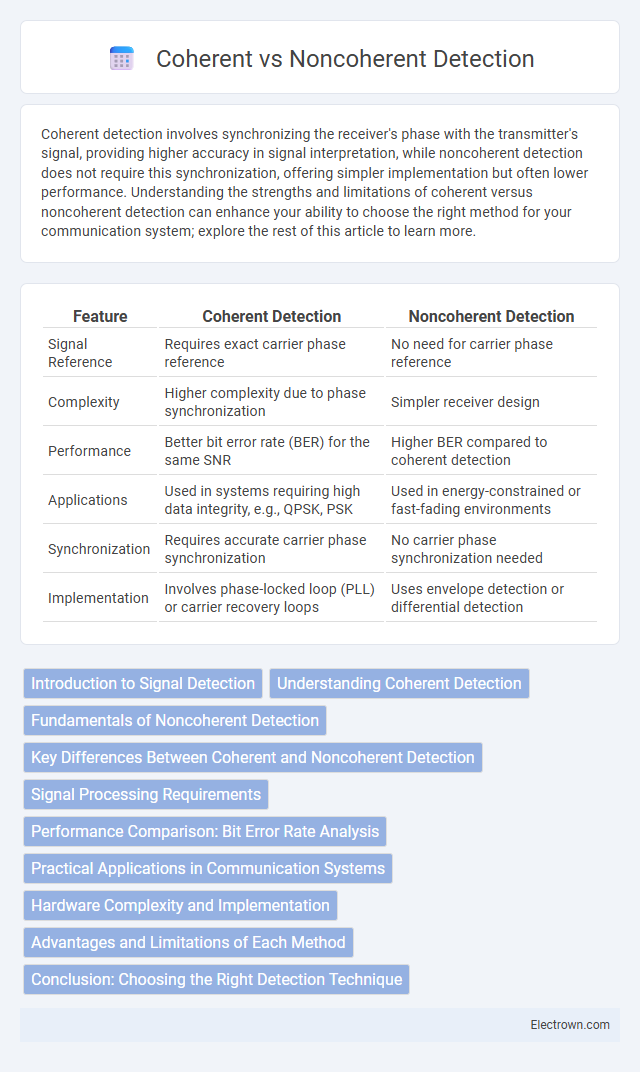Coherent detection involves synchronizing the receiver's phase with the transmitter's signal, providing higher accuracy in signal interpretation, while noncoherent detection does not require this synchronization, offering simpler implementation but often lower performance. Understanding the strengths and limitations of coherent versus noncoherent detection can enhance your ability to choose the right method for your communication system; explore the rest of this article to learn more.
Table of Comparison
| Feature | Coherent Detection | Noncoherent Detection |
|---|---|---|
| Signal Reference | Requires exact carrier phase reference | No need for carrier phase reference |
| Complexity | Higher complexity due to phase synchronization | Simpler receiver design |
| Performance | Better bit error rate (BER) for the same SNR | Higher BER compared to coherent detection |
| Applications | Used in systems requiring high data integrity, e.g., QPSK, PSK | Used in energy-constrained or fast-fading environments |
| Synchronization | Requires accurate carrier phase synchronization | No carrier phase synchronization needed |
| Implementation | Involves phase-locked loop (PLL) or carrier recovery loops | Uses envelope detection or differential detection |
Introduction to Signal Detection
Signal detection involves identifying the presence of a transmitted signal in noisy environments, a critical aspect of communication systems. Coherent detection relies on phase synchronization between the received signal and the locally generated reference, enabling more accurate demodulation for phase-sensitive signals. Noncoherent detection, however, does not require phase information, offering simpler implementation but generally lower performance in terms of error rates, making your choice dependent on system requirements such as complexity and reliability.
Understanding Coherent Detection
Coherent detection involves the use of a locally generated reference signal that is synchronized in phase and frequency with the received signal, enabling accurate demodulation of phase or frequency modulated signals. This method maximizes signal-to-noise ratio by exploiting phase information, making it essential for applications like Phase Shift Keying (PSK) and Quadrature Amplitude Modulation (QAM). Precise carrier synchronization circuits are critical in coherent detection systems to maintain signal alignment and minimize bit error rates in digital communication.
Fundamentals of Noncoherent Detection
Noncoherent detection operates without requiring exact knowledge of the carrier phase, making it suitable for scenarios with rapid phase variations or unknown phase shifts. It relies on energy or envelope detection methods, analyzing the amplitude or power of the received signal rather than its phase information. This approach simplifies receiver design and reduces complexity, though typically at the cost of slightly lower performance compared to coherent detection.
Key Differences Between Coherent and Noncoherent Detection
Coherent detection requires accurate synchronization with the carrier signal's phase and frequency, enabling phase-sensitive demodulation and higher sensitivity in communication systems. Noncoherent detection operates without phase synchronization, relying on envelope or energy detection, which simplifies receiver design but generally results in lower performance under noisy conditions. Key differences include complexity, required synchronization, and robustness, with coherent detection preferred for high-data-rate systems and noncoherent detection favored in simpler, power-efficient applications.
Signal Processing Requirements
Coherent detection requires precise phase synchronization between the received signal and a reference oscillator, demanding complex signal processing techniques such as phase-locked loops and carrier recovery algorithms. Noncoherent detection eliminates the need for phase information, simplifying signal processing by relying on energy or frequency measurements, which reduces hardware complexity and processing power. Your choice between coherent and noncoherent detection impacts the design of signal processing components and overall system performance.
Performance Comparison: Bit Error Rate Analysis
Coherent detection offers a lower bit error rate (BER) than noncoherent detection by relying on accurate phase information of the carrier signal, enabling precise demodulation. Noncoherent detection, which does not require phase synchronization, generally results in higher BER due to its susceptibility to phase ambiguities and noise. Performance analysis shows coherent detection achieves significant BER improvements in noise-limited environments, making it preferable for systems demanding high accuracy and spectral efficiency.
Practical Applications in Communication Systems
Coherent detection is widely used in modern communication systems such as 4G LTE and 5G NR, where precise phase synchronization enables high data rate and spectral efficiency. Noncoherent detection finds practical applications in low-complexity and power-constrained scenarios, like wireless sensor networks and RFID systems, where phase reference recovery is challenging. Your choice of detection method directly impacts system design trade-offs between complexity, performance, and hardware requirements.
Hardware Complexity and Implementation
Coherent detection requires precise phase synchronization between transmitter and receiver, which demands complex hardware components such as phase-locked loops and mixers, increasing implementation complexity and cost. Noncoherent detection eliminates the need for carrier phase recovery, reducing hardware complexity by relying on energy detection or envelope detection circuits that are simpler to implement. The trade-off involves coherent detection offering better performance at the expense of more intricate hardware, while noncoherent detection favors lower cost and simpler design but with reduced sensitivity and higher error rates.
Advantages and Limitations of Each Method
Coherent detection offers higher sensitivity and improved error performance by utilizing phase information, making it ideal for complex modulation schemes but requires precise carrier phase synchronization, increasing system complexity. Noncoherent detection simplifies receiver design by eliminating the need for carrier phase reference, enhancing robustness in phase noise and frequency drift conditions, yet it generally results in lower sensitivity and higher error rates. The trade-off between coherent and noncoherent detection revolves around performance accuracy versus implementation complexity and signal environment adaptability.
Conclusion: Choosing the Right Detection Technique
Choosing the right detection technique depends on your specific application requirements, such as complexity, power consumption, and channel conditions. Coherent detection offers higher accuracy by using phase information but requires synchronization and more complex receiver design. Noncoherent detection sacrifices some performance for simpler implementation and robustness in rapidly varying or unknown phase channels, making it ideal for mobile or low-power devices.
Coherent vs Noncoherent Detection Infographic

 electrown.com
electrown.com